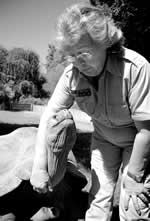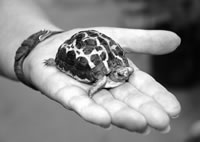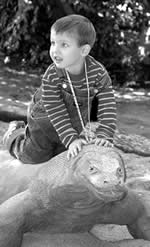Lions, Tigers & Bosco
Despite budget problems, zoo remains one of Fresno's better-known spots
By Rebekah Herbert
You’re in Fresno.
You think there’s nothing to do but go out to the occasional dinner
and movie.
 It’s
a daily relationship going on 20 years now between Mary Morgan, reptile
keeper with Fresno’s Chaffee Zoo, and Knobbie, a tortoise more
than 40 years old. Knobbie sprints to the entrance to his exhibit
every time he hears Morgan’s voice. Photo by Joseph
Hollak It’s
a daily relationship going on 20 years now between Mary Morgan, reptile
keeper with Fresno’s Chaffee Zoo, and Knobbie, a tortoise more
than 40 years old. Knobbie sprints to the entrance to his exhibit
every time he hears Morgan’s voice. Photo by Joseph
Hollak |
But on the corner of Belmont Avenue and Golden State Boulevard sits a
place that has been here longer than most Fresno State students have been
alive and provides hours of fun, entertainment and some good laughs—the
Chaffee Zoo.
And although the Chaffee Zoo isn’t one of the top zoos in the state,
it’s still one of Fresno’s secrets.
The zoo houses about 625 animals on 18 acres of land, each animal with
its own unique story and personality.
“The greatest joy in my job is to be trusted enough to share space
with these animals,” said senior zookeeper Lynn Myers, who has worked
at the zoo for six years. “It takes a long time (to gain that trust),
but when it happens, it is life-altering.”
Myers said there is an age gap in the groups who go to the zoo.
“You experience the zoo when you’re young and then when you’re
old,” Myers said. “There is a college gap where that age group
doesn’t see it, and that’s too bad.”
The most recent addition to the Chaffee Zoo is the giraffe feeding station.
For $2, visitors can feed the giraffes—Uzuri, Angollia, Gamba and
Baba—four times a day. Because giraffes have no upper teeth, there’s
no threat of feeders being bitten.
 The
Chaffee Zoo’s reptile house is the first in the country to successfully
breed spider tortoises in captivity. The
Chaffee Zoo’s reptile house is the first in the country to successfully
breed spider tortoises in captivity.
Photo by Joseph Hollak |
The Fresno Zoological Society sponsored the $90,000 exhibit, the first
since the Sunda Forest opened in 2000.
The daily bird show and the Small Wonders petting zoo are at the top of
the list for visitors’ favorites, in addition to the rainforest
exhibit and the reptile house.
Perhaps one of the most famous animals at the Chaffee Zoo is Bosco, the
34-year-old chimpanzee known for throwing everything he can get his hands
on—including poop.
“Bosco doesn’t like me much,” said zoo curator Dale
Thompson as he scrambled to hide behind a tree, just in time to avoid
being hit by Bosco’s morning biscuit.
Thompson, who has worked at the zoo for six years, said many of the primates
at the zoo have what appears to be trash in their living areas, but it’s
not.
| 
(Bottom left) With the ability to soar above the plains of Africa
for hours at a time, Bateleur Eagles are one of the birds of prey
on display at the zoo. (Bottom right) Following a lunch of whole
cantaloupes, Bulgie the hippo naps in the Fresno heat. (Above) Three-year-old
Ian Enghuasen weighs less than the full-grown Komodo Dragon replica
outside the Reptile House. Photos by Joseph Hollak |
“The animals get bored, so we give them what looks like trash.
Really we might hide their food in it or they may use it as a toy,”
Thompson said. “It keeps them busy and we change it all the time
to give them a new game to play.”
But, not all the animals need something to keep them entertained. The
zoo’s lone hippopotamus, Bulgie, does nothing but lie in his pool
and occasionally open his gigantic 48-year-old mouth when dinner comes
around.
Unfortunately, once Bulgie is gone, there won’t be another hippo
at the zoo due to space and budget issues.
“We have had to move everything closer together because of space,
and another hippo would require the same amount of space as the elephants
have, and we can’t do that,” Thompson said.
The zoo is also home to two Indo-Chinese tigers, one of the rarest and
most endangered species.
“It is difficult finding a way to continue breeding this species
because there are so few of them left that they are all related,”
Thompson said.
Though there are low numbers of some species, there are no breeding problems
with for others.
The flamingos, which have been a part of the zoo since the 60s, reproduce
up to six times a year.
Some of the original flamingos from the exhibit’s first opening
are still there.
The sea lions and harbor seals are also crowd pleasers, periodically plopping
up on the deck to bark and clap at the visitors.
Pismo, the youngest sea lion, was actually a rehab animal found on a beach
in Ventura, Calif. Though most rehab animals are released back into the
wild after they are treated, she was unable to be reintroduced to the
wild. Two-year-old Pismo is blind and was adopted by the zoo.
Although Pismo is not at the barking stage yet, she occasionally squeals
with excitement.
Myers said although the zoo is changing, it still has a long way to go
and needs maintenance work.
“People need to come out to the zoo to see the good parts, but they
also need to see the bad parts too,” Myers said, adding that the
zoo’s 75-year-old underground sewage system needs to be completely
redone.
“We need volunteers, and most volunteers we have are college-aged,”
said Myers. “It is a good experience to learn here before you really
go into it (working with animals). It needs to be explored,” Myers
said.
The Chaffee Zoo is open from 9 a.m. to 4 p.m. until the end of October
and 10 a.m. to 3 p.m. November to January. General admission is $7.
|

